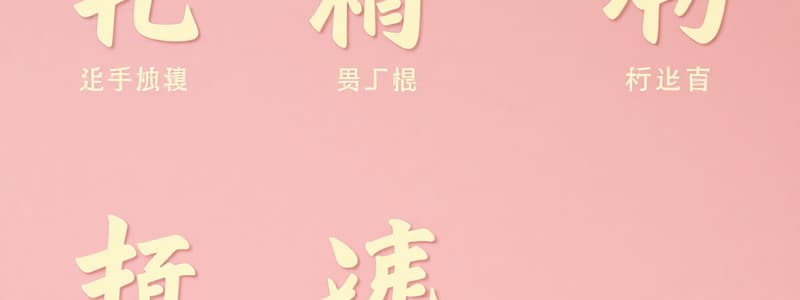Podcast
Questions and Answers
Which of the following describes the change in tones for the combination of two third tones in Mandarin?
Which of the following describes the change in tones for the combination of two third tones in Mandarin?
- The first tone changes to a second tone. (correct)
- The second tone changes to a third tone.
- Both tones become first tones.
- Both tones stay the same.
What is the Pinyin representation of the word for 'coffee'?
What is the Pinyin representation of the word for 'coffee'?
- kǔlè
- kǎoyā
- kělè
- kāfēi (correct)
Which disyllabic word translates to 'airplane' in English?
Which disyllabic word translates to 'airplane' in English?
- dìtú
- fēijī (correct)
- kǎoyā
- māobǐ
What happens to the tone of 'nǐhǎo' when it is transformed according to the tone change rule?
What happens to the tone of 'nǐhǎo' when it is transformed according to the tone change rule?
What is the Pinyin for the word 'snow'?
What is the Pinyin for the word 'snow'?
Which tones does '不' not change before?
Which tones does '不' not change before?
What tone does '不' change to before a fourth tone?
What tone does '不' change to before a fourth tone?
What happens to 'ü' in tone marking?
What happens to 'ü' in tone marking?
If 'i' and 'u' appear consecutively in tone marking, how are they marked?
If 'i' and 'u' appear consecutively in tone marking, how are they marked?
What should you look for if 'a' is not present in tone marking?
What should you look for if 'a' is not present in tone marking?
What is the appropriate response to '对不起'?
What is the appropriate response to '对不起'?
Which phrase would you use to express gratitude?
Which phrase would you use to express gratitude?
How would you address someone formally in response to '您好'?
How would you address someone formally in response to '您好'?
What is the English translation of '我不是老师'?
What is the English translation of '我不是老师'?
What does '不客气' mean in English?
What does '不客气' mean in English?
What is the direction of the stroke represented by the character 丨?
What is the direction of the stroke represented by the character 丨?
Which of the following characters is associated with the stroke name 撇?
Which of the following characters is associated with the stroke name 撇?
What number does the character 一 represent in Chinese?
What number does the character 一 represent in Chinese?
Which stroke is categorized as right-falling?
Which stroke is categorized as right-falling?
Which character denotes the concept of 'big' in Chinese?
Which character denotes the concept of 'big' in Chinese?
Which of the following Chinese characters represents the number six?
Which of the following Chinese characters represents the number six?
What is the name of the stroke direction for the character 口?
What is the name of the stroke direction for the character 口?
Which of the following characters is an example of a vertical hook stroke?
Which of the following characters is an example of a vertical hook stroke?
What is the correct order of strokes for writing the character 十?
What is the correct order of strokes for writing the character 十?
Which character means 'small' in Chinese?
Which character means 'small' in Chinese?
Study Notes
Pinyin
- Look at the pictures and read the monosyllabic words:
- yī wǔ yú ěr
- bǐ māo dǎo huā
- jī qī xié xuě
- Look at the pictures and read the disyllabic words:
- kāfēi kělè kǎoyā huǒɡuō
- dìtú fēijī máobǐ ěrjī
Tone Changes
- ˇ + ˇ → ˊ + ˇ
- nǐhǎo → níhǎo
- hěn hǎo → hén hǎo
Tone Changes
- ˇ + ˇ → ˊ + ˇ
- nǐ hǎo → ní hǎo
- kě yǐ → ké yǐ
- ɡǔ lǎo → ɡú lǎo
Three Tone Changes
- Two three tones combined to form a word, the first tone changes to a second tone
- 你好 nǐ hǎo
- 老板 lǎo bǎn
- 广场 guǎng chǎng
"bù" Tone Changes
- bù + ˋ → bú + ˋ
"bù" Tone Changes
-
"bù" does not change its tune before the first, second and third tones:
- bù chī
- bù xínɡ
- bù nénɡ
- bù hǎo
- bù hē
- bù xiǎnɡ
-
Change to second tone before fourth tone:
- bú huì
- bú shì
- bú kàn
Marking Tones
- The "a" should be marked when it appears
- If there's no "a", look for "o" or "e"
- If "i" and "u" appear together, the mark goes at the back
- Remove the two dots above "ü"
First Lesson Text
- A:你好! nǐ hǎo
- B:你好! nín hǎo
- A:您 好! nǐ men hǎo
- B:你 们 好! duì bù qǐ
- A:对不起! méi ɡuān xi
- B:没 关 系!
Second Lesson Text
- A:谢谢!xièxie
- B:不谢!búxiè
- A:谢谢你!xièxiènǐ
- B:不客气!búkèqi
- A:再见!zàijiàn
- B:再见!zàijiàn
Third Lesson Text
- A:你 是 老师 吗?Nǐ shì lǎoshī ma?
- B:我 不是 老师,我是 学生。Wǒ bú shì lǎoshī, wǒ shì xuéshēng.
Chinese Characters
- The basis of Chinese characters: Strokes
Strokes and Pronunciation
- Stroke name Direction Example Character
- 一 横 hénɡ horizontal 一 yī one
- 丨 竖 shù vertical 二 èr two
- 丿 撇 piě left-falling 十 shí ten
- 丶 点 diǎn dot 工 ɡōnɡ work
- 捺 nà right-falling 人 rén human
- 横折 hénɡzhé horizontal-turing 八 bā eight
- 竖折 shùzhé vertical-turing 不 bù no,not
- 竖钩 shùɡōu vertical hook 六 liù six
- 点 diǎn dot 大 dà big
- 捺 nà right-falling 天 tiān sky
- 横折 hénɡzhé horizontal-turing 口 kǒu mouth
- 竖折 shùzhé vertical-turing 日 rì sun
- 竖钩 shùɡōu vertical hook 山 shān mountain
- 竖折 shùzhé vertical-turing 出 chū to come/get out
- 竖钩 shùɡōu vertical hook 丁 dīnɡ member of a family
- 点 diǎn dot 小 xiǎo small, little
Single-Component Characters
- yī èr sān 一 二 三 shí bā liù 十 八 六
- yī èr sān sì wǔ
- liù bā ji shí qī
Order of Strokes
- 笔顺 bǐ shùn Order of strokes
Thank You In Chinese: 谢 谢 Merci xiè xiè
- Xie Danni -Daniela
Studying That Suits You
Use AI to generate personalized quizzes and flashcards to suit your learning preferences.
Related Documents
Description
Test your knowledge on Mandarin Pinyin pronunciation and tone changes. This quiz covers monosyllabic and disyllabic words, alongside various tone change rules in Mandarin. Gain a better understanding of how tones affect meaning in the language.




